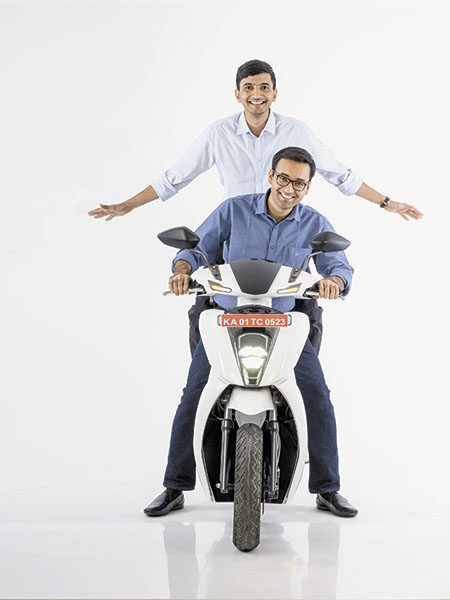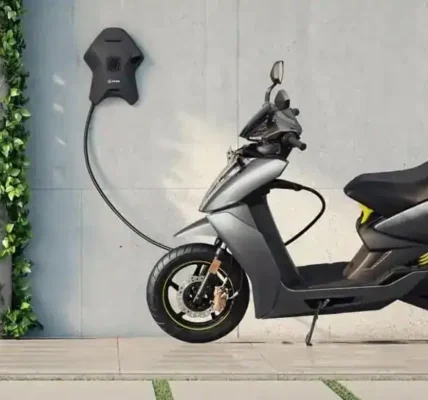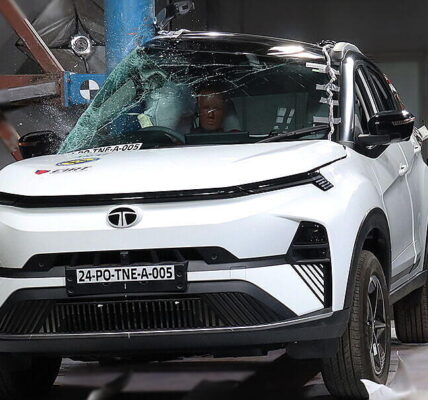When we started Ather, five years ago, it was a daunting challenge that we were preparing ourselves for—that we will build this cool vehicle, but most people will come in with the expectation that ‘electric isn’t fun and it will be a poor experience,’” says Tarun Mehta, co-founder and CEO of Bengaluru’s Ather Energy. “And we were preparing ourselves to educate potential customers about Ather’s scooters.”
Five years on, customers have surprised Mehta, and co-founder and CTO Swapnil Jain, by opting mostly for the more expensive Ather 450 (₹1,13,715 on-road in Bengaluru) over the cheaper Ather 340 (₹1,02,460). It is a sign that electric vehicles (EVs) are being seen as genuine upgrades, Mehta adds. Because he is betting on the electric scooter market really taking off in India in the next few years—the company, however, does not divulge its sales figure—Ather is investing in a new factory to manufacture close to half a million scooters a year. At present, their Bengaluru factory has a capacity of 30,000 units a year. The new factory is expected to be in one of the southern Indian states.
The key to Ather’s success will be its product development prowess and after-sales customer experience, with features such as unobtrusive software updates on the go, says Mehta. He adds that more upfront investments in deep research and development [R&D] will be needed in the country—as against just selling imported scooters—if India aspires to build a strong ecosystem of EV manufacturing.
At Ather, it has taken five years of development to ensure that the scooters are much more than just electric two-wheelers, says Jain. It’s a platform to do many things, much like a smartphone. The built-in computational ability, coupled with the touchscreen user interface, makes several features, such as location-based services, possible. In future, software developers may even be able to build apps for electric vehicles such as these scooters.
The biggest challenge is to build a computationally intensive combination of hardware and software. This means “bringing in more smartness” into the vehicle, Jain says. Adding more sensors, ensuring they work reliably, and creating a “communication architecture” that ensures different components talk to each other in the way they are meant to. Jain says: “We have created a complete hardware and software stack for the two-wheeler environment. There is work on embedded systems, operating systems, applications, data analytics and so on.”
Developing algorithms for using data that the scooters generate, right from the lab to the roads, is an ongoing exercise. The data is used to add features and improve the ride and performance. “How do you determine a turn has been taken, or if the scooter hits a pothole; how do you determine whether there is a single rider or a pillion rider as well? These sort of algorithms are being developed,” Jain says.
Ather has the ability to push software upgrades to its scooters on the go, and it has done five so far. The upgrades improve performance, for instance, through riding modes. “Now we have three modes: Eco, ride and sport,” he says. Navigation, too, now shows multiple routes between two points compared to the single route it would show when it was rolled out.
Other features include ‘guide-me-home’—where the headlamps stay lit for 10 seconds after the vehicle is switched off—and turning indicators that switch themselves off, usually found in cars; rider analytics provide data on how the scooter has been used. A dark mode for the display, and range estimation based on routes are expected in the future.
Product development and engineering was “both situational and intentional”, Jain says. “On the one hand there was very little available off-the-shelf, and on the other, we didn’t want to be just a vehicle assembler,” he says. “The electric power train and the software [that Ather has built] are areas where no conventional original equipment manufacturer in India has a good understanding.”
Ather has put together a 200-strong product development and engineering team, which is based in Bengaluru. The company can now innovate at a pace that no one else can in the country, says Jain. “It took us five years to bring this all together, but now the possibilities for innovation will develop exponentially.”
So far, Ather has raised $91 million in funding from investors such as Hero MotoCorp, Sachin Bansal and Binny Bansal (founders of ecommerce platform Flipkart), and InnoVen Capital. It has applied for 51 patents in India, of which one has been granted; internationally it has applied for 11 patents.
Indigenisation is a very important aspect, because if the government wants India to become a global player in electric two-wheelers, it can’t be done through just manufacturing. “You first need to own the product, the engineering,” says Mehta. Therefore, what companies such as Ather are doing becomes important for the entire ecosystem, he adds; there must be an appetite for investing in engineering and product development.
But this doesn’t mean everything has to be done in-house. For instance, Ather’s batteries, frame and wiring harnesses are built in-house, while motors are sourced from a European vendor. Jain expects they can make their own motors in the foreseeable future, but switching to them will depend on cost viability.
“Companies such as Ather Energy have designed electric scooters from scratch, and have really made the scooters cool,” says Vinay Piparsania, global consulting director-automotive at Counterpoint Technology Market Research. “Even though they have priced their scooters higher [than comparable 125 cc petrol scooters], that is where the strategy should have been in the first place”, just like Tesla, which didn’t come out with a basic car, but a luxury one. Buyers in this segment don’t care so much about the price and are early adopters, he says.
“Ather has created quite a niche for itself by starting afresh, giving a high power motor, high range, connectivity and features that made the scooters appealing to affluent early adopters,” Piparsania says. For instance, compared to the similarly priced Okinawa Praise Pro (from Gurugram-based Okinawa Autotech), Ather 450 offers higher engine power and top speed. They have addressed other aspects of the ecosystem too, such as the retail experience and charging stations, which will make them a fairly successful company, he adds.
Ather is trying to address the entire experience of owning an EV, including how it’s charged and serviced, says Ravneet Phokela, its chief business officer. For now, it installs charging ports at customers’ homes for free, and is expanding its public charging network. Scooters are usually charged overnight at homes, while charging at public places tends to be a top-up.
The way in which EVs are maintained and serviced are very different from conventional vehicles. In vehicles with internal combustion engines, usually the only way to figure out what is wrong is to take them to a service centre, where the vehicles are opened up. The servicing of EVs is very different, where both technology and customer experience are concerned.
Ather sells it scooters online, although it has customer experience centres in Bengaluru and Chennai, and expects to expand to Hyderabad and Pune. It offers doorstep servicing, and replacement vehicles when required, and customers are unlikely to ever see an actual service centre, which is a backend process and not a customer-facing one. With Ather’s scooters, data is readily available and can be analysed in real time. Financing, too, can be structured differently for vehicle servicing and sales, with data on the vehicle’s performance and usage making the process more transparent.






